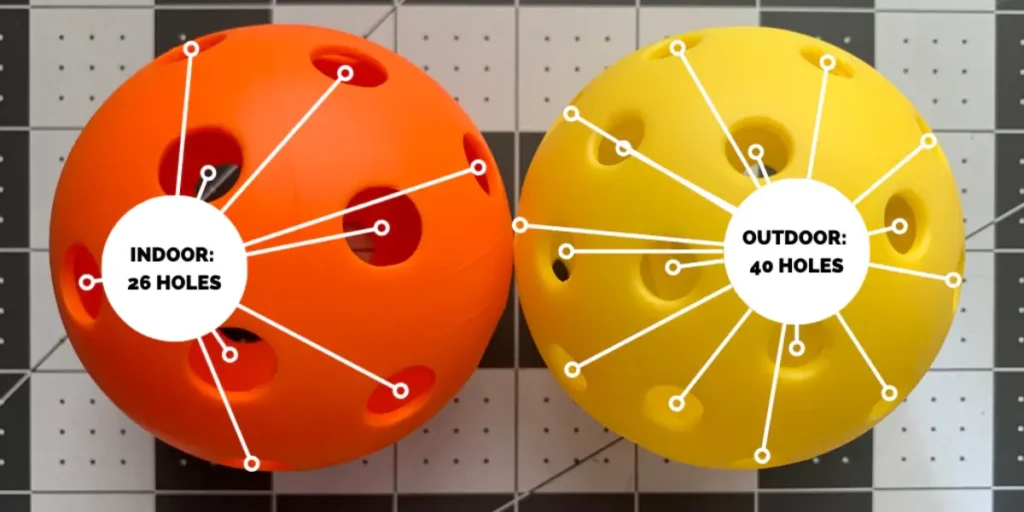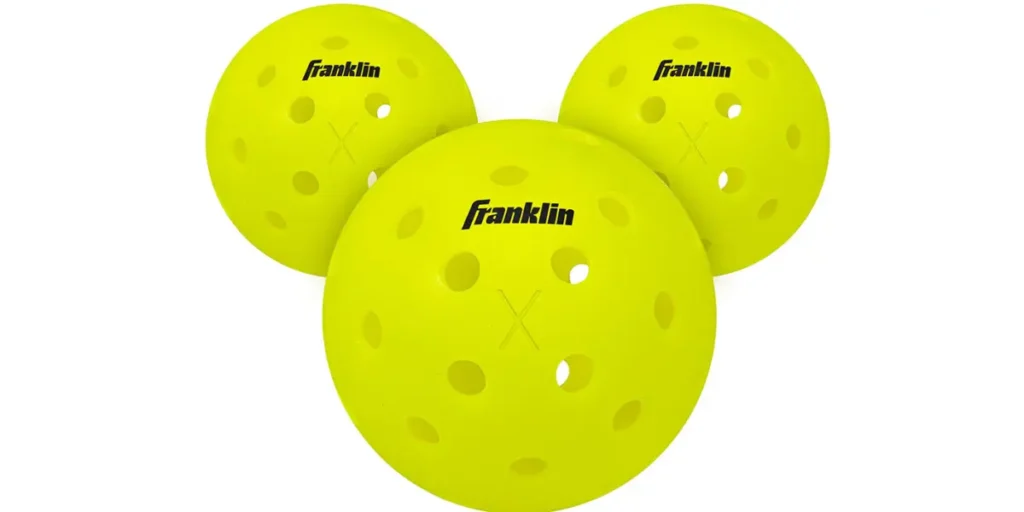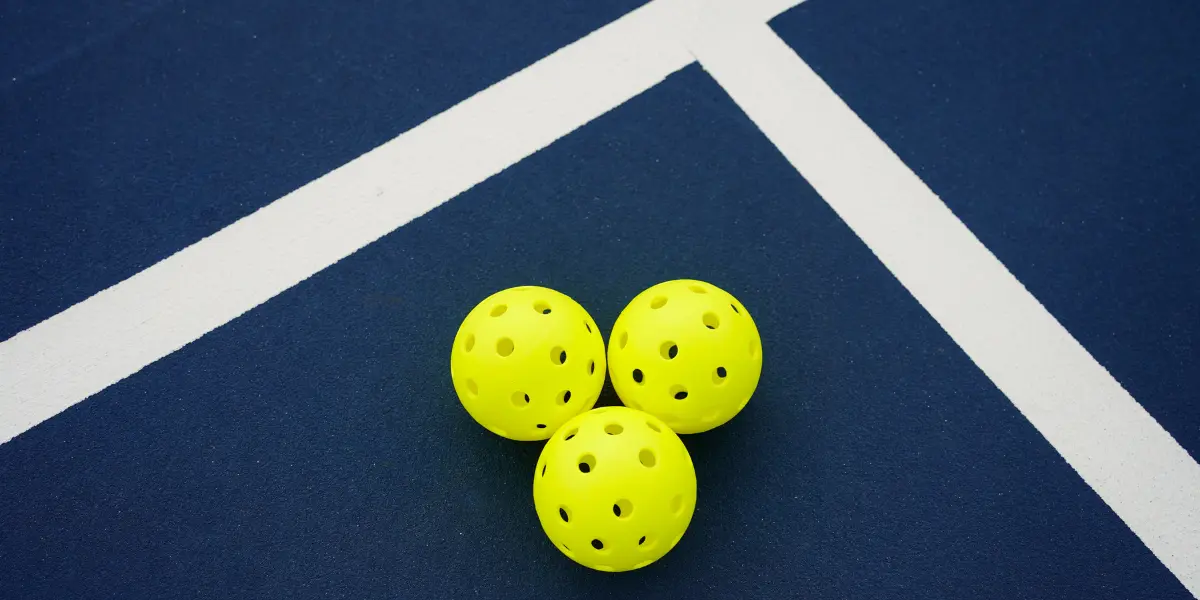Choosing the wrong pickleball for your playing environment can throw off your entire game, even if your technique is solid. The difference between indoor and outdoor pickleballs isn’t just about where you play; it’s about how the ball performs in real-game situations. Flight, bounce, durability, and even sound change based on the ball you’re using.
That’s why experienced players never treat all pickleballs the same. If you’re unsure whether your current ball is holding you back, this breakdown will help you understand what truly separates indoor from outdoor pickleballs and which one you should be using.
Before going further, check out how pickleballs are made. It’ll help you understand the basics before we explore the differences.
7 Main Differences Between Indoor and Outdoor Pickleballs
Though they may look similar at a glance, indoor and outdoor pickleballs are built with different environments and challenges in mind. Their construction affects everything from ball speed to bounce behavior, and understanding those differences can help you choose the right one for your game.
| Feature | Indoor Pickleballs | Outdoor Pickleballs |
|---|---|---|
| Hole Design | Fewer (26), larger holes | More (40), smaller holes |
| Material | Softer plastic | Harder plastic |
| Weight | Lighter (0.8–0.9 oz) | Heavier (0.9–1.0 oz) |
| Bounce | Lower, more controlled | Higher, faster bounce |
| Speed | Slower, ideal for control | Faster, suited for quick rallies |
| Sound | Quieter on contact | Louder on impact |
| Best Surface | Indoor gym floors | Outdoor courts (concrete/asphalt) |
| Durability | Durable indoors, not ideal for outdoor use | Built for outdoor use, can crack over time |
Indoor Pickleballs
Indoor pickleballs are designed for control and longer rallies. They’re typically played on smooth surfaces like wooden or synthetic gym floors, where wind and weather aren’t a factor. Because of this, the ball is softer, slower, and more predictable, ideal for players who prioritize placement and finesse.
Key traits of indoor pickleballs:
- Hole Design: Feature 26 large holes (approx. 0.28–0.30 inches). The larger size creates more air resistance, which slows the ball down and gives players more control over placement and spin.
- Material: Made from softer plastic, allowing the ball to compress slightly on impact. This reduces bounce and gives a more cushioned, controlled response.
- Weight: Slightly lighter (0.8–0.9 oz), which contributes to slower flight speed and easier shot timing during long rallies.
- Bounce: Bounces lower and softer, making it easier to play soft shots like dinks or controlled volleys.
- Speed: Moves slower through the air, helping players set up more strategic plays.
- Sound: Produces a quiet “thud” sound—ideal for echo-prone indoor environments.
- Best Surface: Performs best on smooth gym floors or wooden surfaces, where friction is low.
- Durability: Durable indoors, but the softer material wears out quickly if used on concrete or asphalt.

Outdoor Pickleballs
Outdoor pickleballs are built to handle tougher conditions, like wind, rough courts, and varying temperatures. They’re heavier, harder, and faster, making them better suited for open-air play where consistency is harder to maintain.
Key traits of outdoor pickleballs:
- Hole Design: Have 40 small holes (approx. 0.24–0.26 inches). Smaller holes reduce air drag, helping the ball maintain speed and a straight path, especially in windy conditions.
- Material: Constructed from harder, more rigid plastic, which makes the ball bounce more sharply and resist impact from rough surfaces.
- Weight: Slightly heavier (0.9–1.0 oz) to stay stable outdoors. This helps keep the ball from wobbling in the wind or bouncing unpredictably.
- Bounce: Produces a higher, quicker bounce, ideal for fast volleys and strong baseline returns.
- Speed: Moves faster and more aggressively, which demands quicker reflexes from players.
- Sound: Hits with a louder “pop” sound, due to the harder shell and surface impact.
- Best Surface: Performs best on asphalt, concrete, or outdoor composite courts that demand more rugged play.
- Durability: Built to last outdoors, but can crack or split over time with sun exposure or in cold weather.
When to Use Indoor vs Outdoor Pickleballs
If you’re playing on a smooth indoor surface with no wind interference, an indoor pickleball will give you better control and more consistent touches. On the other hand, if you’re playing on rough concrete or asphalt under open skies, an outdoor pickleball offers the weight and stability needed for fast-paced rallies, even in windy conditions.
Use Indoor Pickleballs When
- You’re playing in a gym, rec center, or indoor sports facility
- You want slower, more controlled gameplay
- You prefer longer rallies and more dink-based strategies
- You want to reduce noise (indoor balls are quieter)
Use Outdoor Pickleballs When
- You’re playing on outdoor courts like concrete or asphalt
- You need a ball that can resist wind interference
- You’re looking for a faster-paced game
- You want durability against rough surfaces and UV exposure
Using the wrong ball in the wrong environment can throw off your timing, ruin your rallies, and lead to early wear on the ball or even your paddle. Choosing a ball from a reliable brand ensures consistency in gameplay, especially if you’re switching courts or playing across different locations.
Popular Pickleball Brands and Recommended Balls
With so many options on the market, choosing a quality pickleball can be overwhelming. However, a few brands have earned strong reputations among both recreational and competitive players.
For indoor play, the Onix Fuse Indoor is one of the most widely used options. It’s designed with 26 large holes and offers excellent control with a soft touch, perfect for gym floors and controlled rallies.
Another favorite is the Jugs Indoor Pickleball, known for its soft feel and quiet bounce, often recommended for beginners or community centers.

When it comes to outdoor pickleballs, the Franklin X-40 is a top choice. It’s approved for tournament use and strikes a great balance between speed, durability, and flight stability.
The Dura Fast 40 is another professional-grade outdoor ball. It’s slightly harder and faster, making it popular in high-level competitions, though it may wear out faster on rough surfaces.
Choosing a ball from a reliable brand ensures consistency in gameplay, especially if you’re switching courts or playing across different locations.
Tips for Choosing the Right Pickleball Ball
Choosing the right pickleball comes down to three main factors: court surface, play style, and game setting.
For indoor courts, a softer ball provides better touch, more control, and reduced noise, ideal for longer rallies and finesse play. On rough outdoor courts, a harder ball holds up better, resists wind, and keeps the pace fast and consistent.
Your playing style also matters. If you prefer slower, tactical games with more dinking, an indoor ball may suit you, even on mild outdoor days. But if you enjoy fast-paced drives, a heavier outdoor ball offers more power and stability.
Lastly, check the list of USAPA-approved balls if you’re playing in tournaments. This ensures you’re practicing with the same type used in official matches.
FAQs
Yes, indoor balls are made from softer plastic, which helps reduce bounce and gives players more control during rallies. Outdoor balls are firmer to handle rough surfaces and wind.
You can, but the game will feel faster and less controlled. Outdoor balls tend to bounce higher and move quicker on smooth indoor floors, which may affect timing and placement.
Outdoor balls face tougher conditions, sun, wind, rough surfaces, and temperature changes. These factors make them more likely to crack or lose shape over time, especially in cold weather.
Usually, yes. Indoor balls are used on smooth, controlled surfaces, so they experience less impact stress. Outdoor balls take more abuse from hard courts and environmental exposure.
A well-made outdoor pickleball with smaller holes like the Franklin X-40, is ideal. It’s designed to stay stable in wind and perform consistently on outdoor courts.
Conclusion
Understanding the difference between indoor and outdoor pickleballs isn’t just a technical detail, it directly impacts how you play.
From hole size and bounce to durability and speed, each type of ball is built for a specific environment. Indoor balls offer better control and quieter play, while outdoor balls provide durability and consistent performance in unpredictable conditions.
Using the right ball for your court ensures smoother rallies, fewer distractions, and a more enjoyable game overall. Whether you’re practicing casually or playing competitively, matching your gear to your environment is a small change that makes a big difference.

